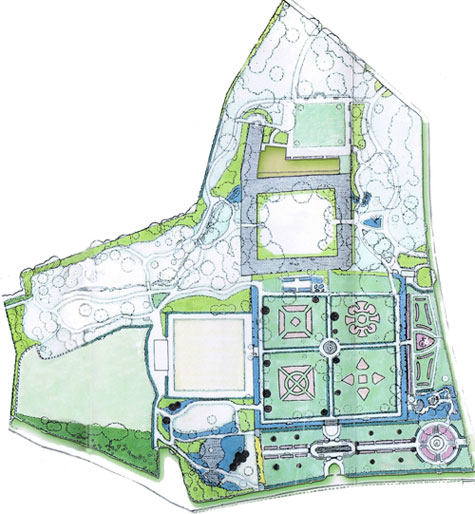Overview:

At the front of the Pleasaunce is an area designed in the shape of a shield; this has been raised in recent years to make viewing from Well Hall Road eaiser. Each year, the design is a motif on behalf of a local organisation. Last year it was the Eltham Society; this year it will commemorate a 100 years of the scouting movement
Until recent years this has been an 18 hole green but now is used for the twice-yearly events held at the Pleasaunce, in May and August. It is also subject of a grant application by the Friends to create a woodland trail, thickening up the cover of trees at the west end and a wildflower meadow alongside. It is hoped to attract local organisations and schools to take active participation in the planting and design
The front of the Pleasaunce, alongside Well Hall Road, is the site of the old Well Hall House, built in the 1730s and demolished two hundred years later. It's most famous occupants were John Arnold, watchmaker to George 111 and Railway Children author E Nesbit and her husband, leading Fabian Hubert Bland.
The bridge from the Well Hall frontage into Moat Island dates back to the 16th century. Eltham is uniquely bestowed with two ancient bridges, the other at the entrance to Eltham Palace. The one in the Pleasaunce is a stone bridge of two arches with red vrick parapets. Sadly, duckweed clogs the Moat at this point for most of the year, giving a neglected appearance to visitors. The Friends are trying to persuade the council's Parks Department of the need to clear this regularly.
The rockery between the shield garden and the sunken garden was renovated in 2002 and is starting to mature. A small stream runs from the Well Hall Road side into two ponds, which both attract amphibians in the spring. There are a number of attractive plants which provide year-round interest.
The Italian garden was laid out in the 1930s when the Pleasaunce was created from the gardens of the 18th century house, latterly occupied by E Nesbit. This was retained and re-emphasised in the renovations in 2002 with selective replacement of the larger conifers with the narrow varieties more typical of an Italian garden landscape. The sunken garden was also created at that time; until recently it was planted with rose bushes; now its focal point is exotic species - in 2006 a banana tree - and colourful planting
The wisteria arch at the end of the Italian garden is one of the Pleasaunce's most popular features. In late Spring most spectacularly and often again in early autumn, the pergola is ablaze with bright purple. The plants, some of which are believed to pre-date the stone framework, are thought to be up to 100 years old and are skilfully pruned by the Pleasaunce's gardening team to ensure maximum flowering.
There are four bowls clubs, three for men, one for women, which play each day throughout the summer with use of the pavilion. One lane is available for members of the public to use. Names and contact details will be added to this site nearer the start of the season in April.
The Park, in Well Hall Road, Eltham, is open every day from around 8am to dusk excluding Christmas Day, Boxing Day and New Year's Day. Rangers from Greenwich Council's conduct guided walks on the first Wednesday of each month at 10.30am and the second Sunday at 2pm.
The walled garden in a central feature of the Pleasaunce. It was used as a kitchen garden and orchard attached to the 18th century house which was situated between the Moat and Well Hall Road, its last occupant being the children's author E Nesbit
The Tudor Barn was an outbuilding to the original mansion which was in the centre of the Moat and occupied most famously in the 16th century by William Roper and his wife Margaret Roper, daughter of Henry V111's Lord Chancellor, Thomas More. The Barn has been opened as a first-class function venue, restaurant and day-time cafe. For full details see www.tudorbarneltham.co.uk or ring 0845 459 2351
The woodland glen has an a mixture of unusual trees, which is a hallmark of the Pleasaunce. In all, there are 230 trees, with many varieties. In the woodland glen alone there is an Indian Horse Chestnut, a paperbark maple, a strawberry tree and a ginkgo. Between the glen and the putting green is a metasequoia. The ground area is becoming a wildflower meadow. It receives its first cut only in mid-summer in order to allow flowers to seed; the grass cuttings are removed to reduce the fertility. It is hoped the old wildflower seeds remaining dormant will be encourageds to take hold.
The Moat is one of the oldest features of the barn. It surrounded the original mansion, knocked down in the 1730s. It then became a feature of the back garden of the new house, situated between it and Well Hall Road and E Nesit, the Railway Children's author, would punt in it. The bridge which leads from the front of the Pleasaunce into Moat Island is original, probably 16th century and is one of two of this age in Eltham - the other leading to Eltham Palace. In the refurbishment of 2002, the Moat was restored, with new brick work and water-proof lining. Water-side plants were added and these act as nesting places for mallards and moorhen.
The Pleasaunce has a number of ponds which play host to frogs, newts, dragon and damselflies and water lillies. They include the Italianate long pond, home to an amazing variety of lillies; the top pond, surrounded by grasses and rushes and home to amphibians; and the small ponds at the front of the park, also useful refuges for wildlife.
|